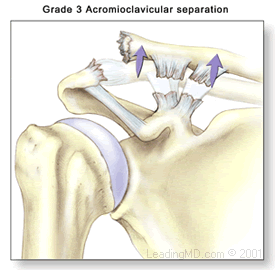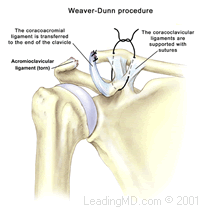
How is an acromioclavicular separation treated?
The treatment of an AC separation depends on the grade of
the injury. The classification helps the physician choose
the correct treatment approach. Grades I - III are usually
treated non-operatively. The vast majority of patients will
have a period of discomfort. Once this discomfort disappears,
the shoulder is usually fully functional, although the patient
may still have a minor cosmetic defect at the injury site.
Some patients with grade III AC separations may be candidates
for early surgical reconstruction. A discussion between the
physician and patient should focus on the patient's expectations
and possible return to sports. Many surgeons prefer to first
treat the AC separation conservatively. If grade III patients
develop problems or do not heal properly surgical reconstruction
is an option. (Conservative and surgical treatment for grades
I - III have essentially the same results after 1 year.)
 Non-Operative
Treatment Non-Operative
Treatment
Most Grade I - III AC separations are treated successfully
with non-operative treatment that may include:
ice to reduce pain and swelling.
rest and a protective
sling until pain subsides. This usually takes about 1-2 weeks.
pain and anti-inflammatory medications.
A rehabilitation program to restore normal motion and strength
is begun as soon as tolerated with gentle exercises and progresses
as healing allows.
Depending on
the grade of injury, most patients heal within 2 to 3 months
without surgical intervention. The patient is allowed
to return to sports when there is full and painless range
of motion, no more tenderness when the AC joint is touched,
and manual traction does not cause pain. This usually takes
about 2 weeks for a grade I injury, 6 weeks for a grade II
injury, and up to 12 weeks for a grade III injury.
Operative Treatment
Surgery may be necessary for AC separations that do not respond
well to non-operative treatment. If, after 2 to 3 months,
pain continues in the AC joint with overhead activity or in
contact sports, surgery may be necessary. There
are some physicians who offer early surgery for a select group
of Grade III AC separations based upon the activities and
demands these patients place upon the shoulder.
These patients include:
- young, active individuals
(over the age of 13).
- laborers whose jobs require
heavy overhead work.
- athletes in non-contact sports
whose overhead movements are stressful and frequent.
A variety of surgical methods have
been used to stabilize a separated AC joint. The surgical technique
most often performed involves the reconstruction of the coracoclavicular
ligaments and the excising (removal) of the distal
(shoulder) end of the clavicle. Distal clavicle resection
without the repair of the ligaments may lead to excessive rotation
of the scapula. Reconstruction studies show that the AC
joint can be adequately stabilized by : 
- a fixation across the acromioclavicular
space with pins or plates.
- loop fixation from the clavicle
to the coracoid process using synthetic materials.
- The most common reconstructive
procedures today use a screw or suture loop to stabilize
the joint.
In a distal clavicle resection,
about 10-15mm of the clavicle is removed through a two-inch
incision above the joint. The AC ligament is then transferred
from the bottom of the acromion into the cut end of the clavicle
to replace the torn ligament.
What types of complications may occur?
Complications of AC joint injuries are persistent instability
of the shoulder girdle or residual pain with activity. These
complications can be present with either non-operative treatment
or operative treatment. Failure of the acromioclavicular ligament
and coracoclavicular ligaments to heal can lead to pain and
a sense of instability with overhead activity. If the end of
the clavicle remains unstable because of lack of scarring, contact
sports or overhead tasks may be painful.
Other complications associated with
the reconstruction of the AC or CC ligaments are related to
hardware failure. Fixation of the clavicle to the coracoid process
is difficult because of the rotation of the clavicle with all
overhead activity. The screws used to fix these two bones together
can pull out if the patient does not wear a sling after surgery
as instructed.
Most surgeons today will securely fix the clavicle to the coracoid
with dissolvable sutures or with a screw that is removed at
about three months. |

